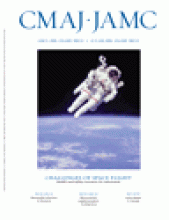A 30-year-old man with hemoptysis presented to a hospital in India. During examination, he coughed up a white membranous structure 3 cm long (Figure 1). A radiograph of the chest showed numerous masses in the left hilar region and a calcified mass near the right dome of the diaphragm (Figure 2). A computed tomography (CT) scan of the chest showed 3 hydatid cysts in the right hemi-thorax. A CT scan of the abdomen showed a large hydatid cyst, with multiple daughter cysts, in the liver. (The CT scans are available at www.cmaj.ca/cgi/content/full/cmaj.081217/DC1.) Serologic testing for echinococcosis showed an IgG titre of 1:1600 (normal < 1:1000). The patient was given albendazole 800 mg/d orally for echinococcosis, amoxicillin–clavulanate 675 mg orally twice daily for pneumonia and tranexamic acid 2 g/d parenterally as an antifibri-nolytic to control hemoptysis.
Figure 1: A 3-cm-long capsule of a hydatid cyst that was coughed up by a 30-year-old man with echinococcosis.
Figure 2: Radiograph of the chest, showing numerous masses in the left lung and hilar area (white arrows) and a mass near the right dome of the diaphragm with a crescent-shaped calcification (black arrow), indicating a nonmalignant lesion.
Echinococcosis or hydatid disease is commonly caused by the tapeworm Echinococcus granulosus. It is endemic in many countries, including India. The definitive hosts of this parasite are carnivores (e.g., dogs, bears and foxes). After an intermediate host (e.g., humans, and herbivores such as cows and sheep) ingests tapeworm eggs from the feces of an infected carnivore, the eggs hatch in the host’s digestive system. The larvae migrate through the blood and lymph vessels to the liver, lungs and other organs, where they develop into hydatid cysts. 1,2
Clinical presentation of echinococcosis may be related to rupture of cysts, compression of vital structures or secondary infection. Symptoms vary depending on the organ system involved. Diagnosis is based on radiography, ultrasonography and computed tomography. Although serologic testing can be helpful, it is notoriously insensitive in detecting E. granulosus in pulmonary disease. 1 Treatment options include surgical removal of the hydatid cysts, chemotherapy with prazi-quantel, mebendazole and albendazole, and PAIR (puncture, aspiration, injection and reaspiration). 1,2 PAIR involves puncture of the cyst, aspiration of the contents, injection of an ethanol or hypertonic saline solution, and reaspiration of the cyst contents. Puncture and aspiration are not indicated for pulmonary cysts. Chemotherapy is usually recommended after surgical intervention to prevent the spread of any remaining larvae. Cysts that are large or complex generally require surgical removal.










